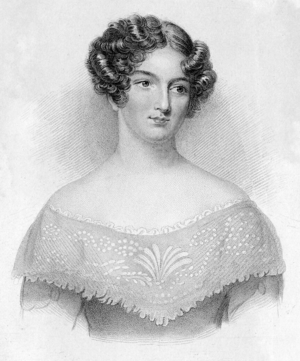Silver-fork novels, also known as fashionable novels, belong to a genre of 19th-century English literature that depicts the lives of the upper class and the aristocracy, a form that dominated the English literature market from the mid-1820s until the mid-1840s. They were often indiscrete, and keys to the principal characters would occasionally be circulated, identifying the real people on whom they were supposedly based.[2] Most silver-fork novels were published by Henry Colburn (1784–1855), “who was adept at blurring the boundaries between scandalous memoirs and fiction in ways that made an author’s private life and social position commodities which could be turned for profit”.[3]
The term has been applied to works by Theodore Hook, Catherine Gore, Frances Trollope, Lady Caroline Lamb, Benjamin Disraeli, and Susan Ferrie.[4] The first novel written in the silver-fork style was Theodore Hook’s Sayings and Doings (1824), but the best example of the genre is generally considered to be William Makepeace Thackeray’s Vanity Fair (1847–48).[5][6]
The silver-fork genre has its roots in the 18th-century novel of manners. and the term may have been coined by the writer and hoaxer Theodore Hook (1788–1841),[a]Theodore Hook is best known for his practical jokes, particularly the Berners Street hoaxHoax perpetrated by Theodore Hook in Westminster, England, in 1810. Hook had made a bet with his friend, Samuel Beazley, that he could transform any house in London into the most talked-about address in a week, which he achieved by sending out thousands of letters in the name of Mrs Tottenham, who lived at 54 Berners Street, requesting deliveries, visitors, and assistance. in 1810.[7] who expressed a fascination that the upper classes ate their fish with a silver fork.[5] Alternatively, it may have been an invention of the essayist and critic William Hazlitt, after the upper-class practice of eating fish with two silver forks.[8] Hazlitt was particularly critical of the “under-bred tone” of the silver-fork novels, written as they increasingly were by “middle-class would-be members of fashionable society”.[9]
Notes
| a | Theodore Hook is best known for his practical jokes, particularly the Berners Street hoaxHoax perpetrated by Theodore Hook in Westminster, England, in 1810. Hook had made a bet with his friend, Samuel Beazley, that he could transform any house in London into the most talked-about address in a week, which he achieved by sending out thousands of letters in the name of Mrs Tottenham, who lived at 54 Berners Street, requesting deliveries, visitors, and assistance. in 1810.[7] |
|---|

